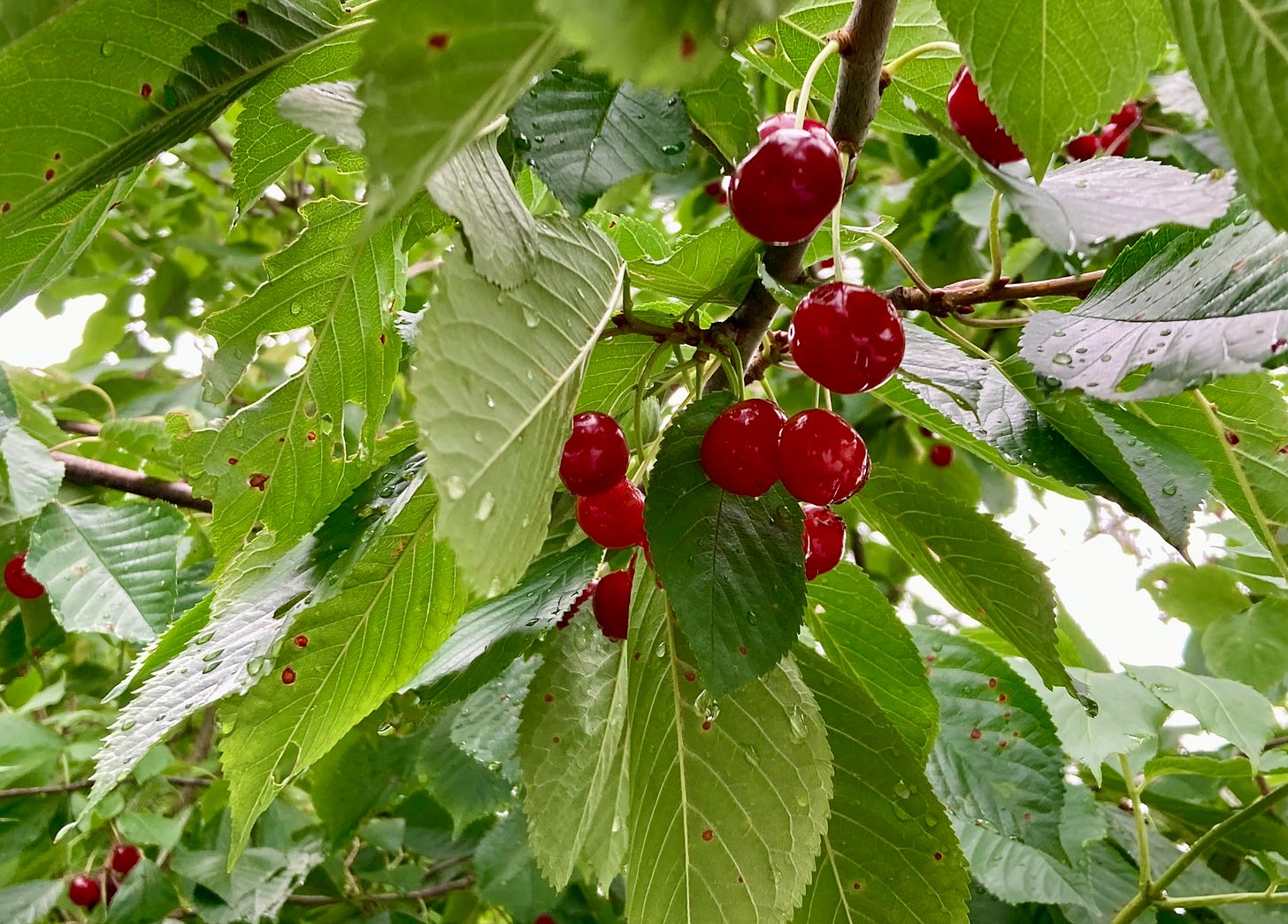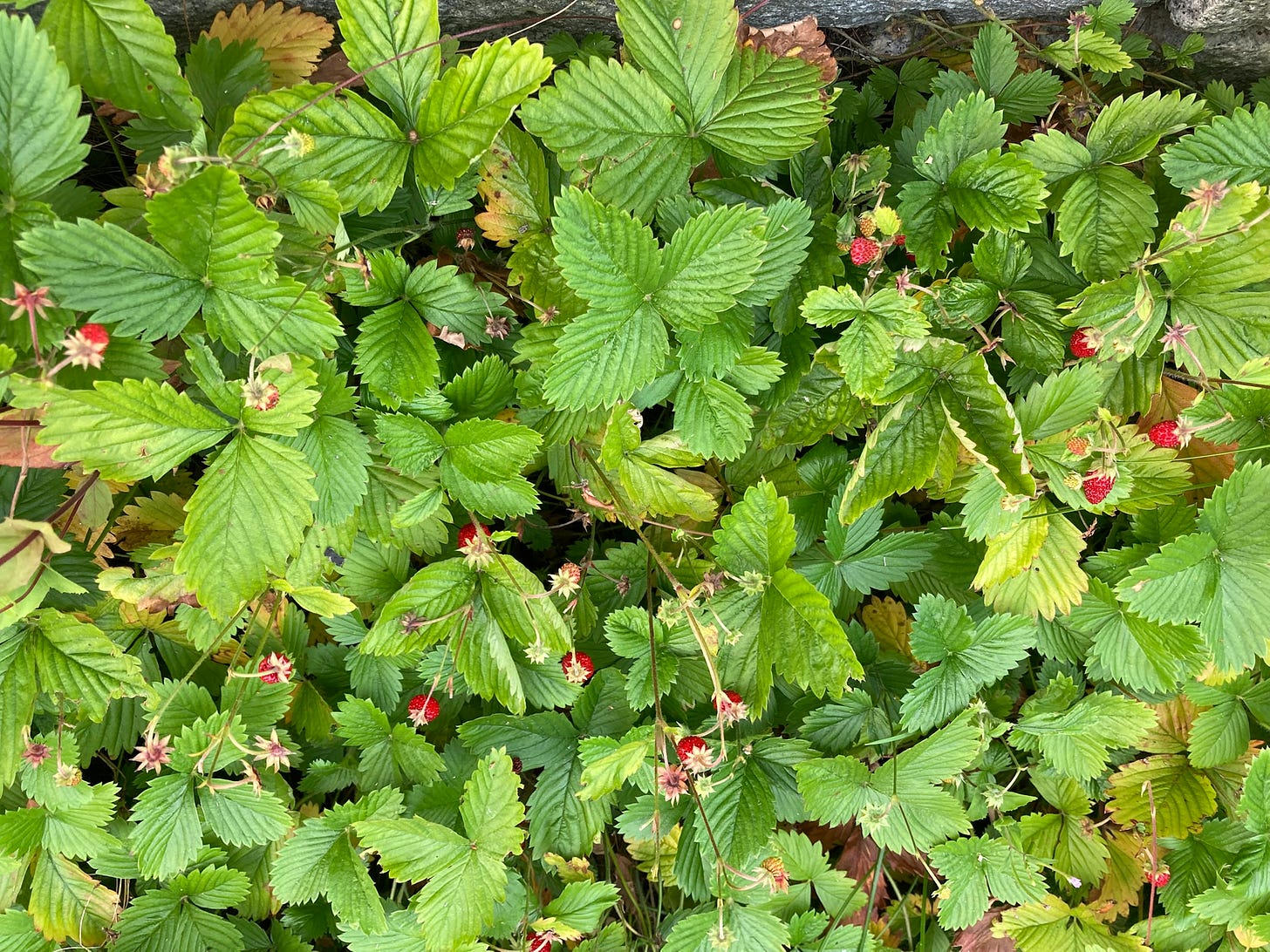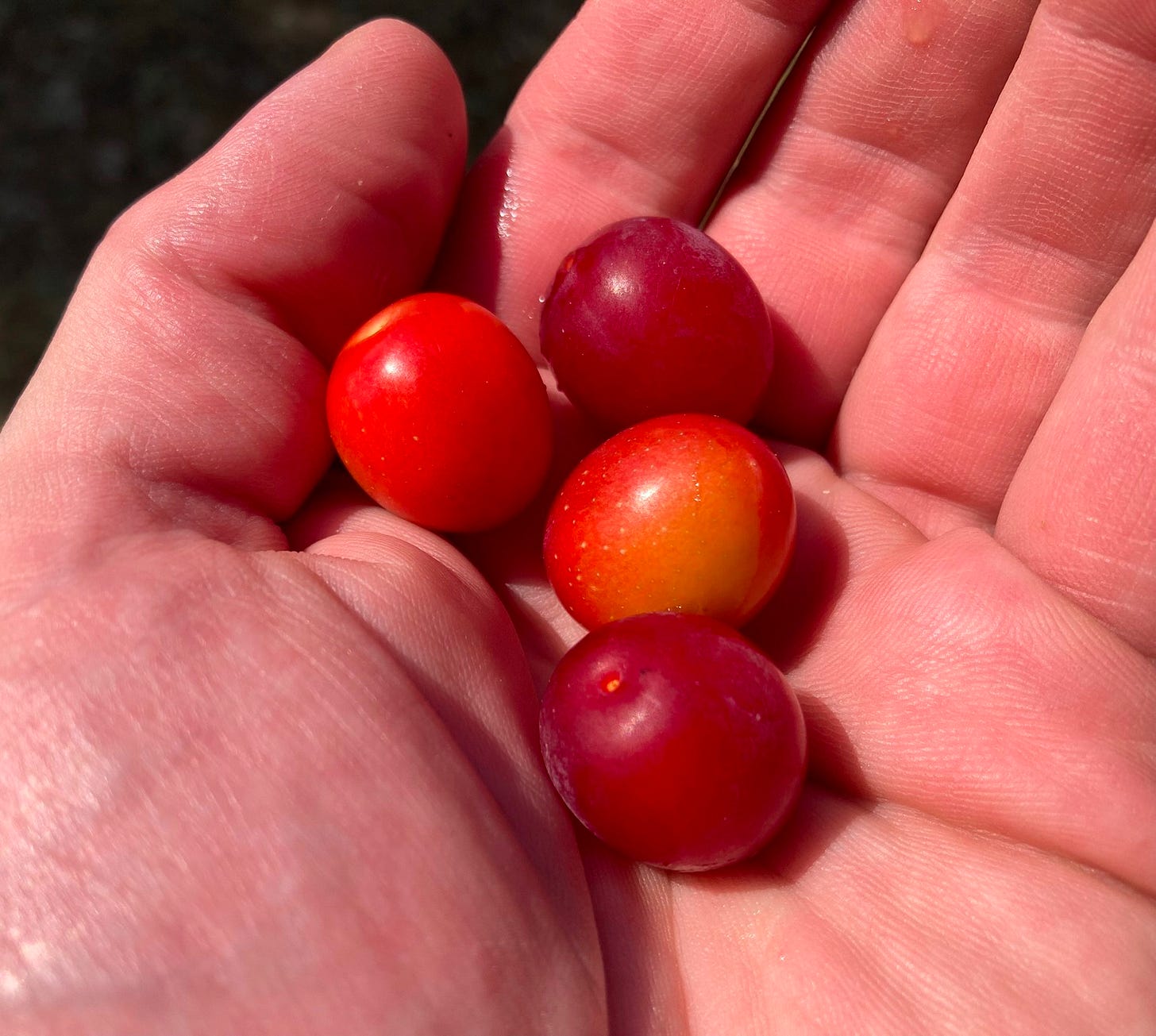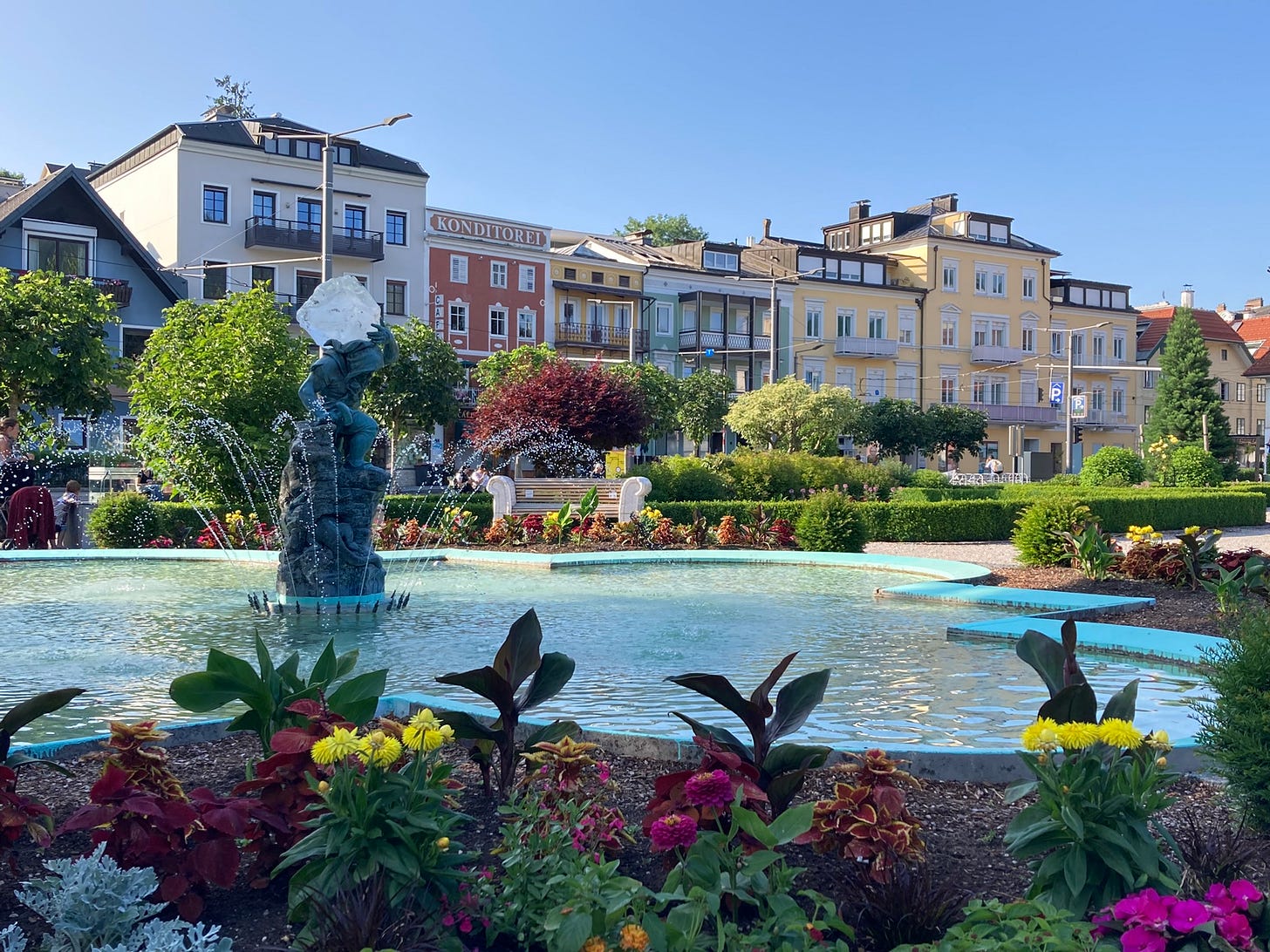If there’s one place that’s custom-made for successful temperate fruit production, it seems to be our region of Austria. Let me show you what we and our neighbors grow. But first, a little map showing our approximate location in the heart of Europe, and the prevailing WNW wind direction.

The same Westerlies that bring a mild climate to France tiptoe their way across Germany and settle on the Austrian Alps. High up we marvel at the year-round snow, but here in the foothills we enjoy a climate tailor-made for temperate fruit production. We bask in 2000 hours of sunshine per year, enjoying the gentle rains of summer, taking walks in a winter wonderland straddling either side of freezing: crisp enough to rejuvenate you, cool enough to let the plants hibernate. In midsummer the sun shines for 16 hours per day, the lakes and rivers percolate to perfection, and the air buzzes with bees and honey-kissed warmth. In statistical terms, we average highs of 26°C/79°F in the summer, and 3°C/38°F in the winter. Our growing season (frost-free period) is typically nearly 7 months, around 200 days. Yet we lie north of Fargo and Odessa. We receive these gifts in Upper Austria, and this is what we grow with them:
The humble apple (Apfel) comes in thousands of varieties worldwide. In our garden we cultivate an unknown red variety that is very mild and durable, and a kind called Klarapfel (“clear apple”) that we use to make juice. Neither are particularly photogenic, so I have included our neighbor’s beautiful fruits above. Frankly, neither would win any taste contests either, but we are content with them for not just juicing, but also various recipes. Our first ripe apple fell on June 27th this year. If I told you that one tree produced over 10,000 apples last year, you might not believe me, but nevertheless, that is my estimate. I counted most nights in July and averaged 180 apples on the ground each night. August was about 120. September started strong but petered off. At one point I was eating 20 apples per day, and we gave the rest away or made juice. Well, we had to throw out many as well. The wasps love them and become drunk from eating the fallen fruit. I felt fine eating so many apples, as the ones we grow are high in water and low in sugar. I believe if you ate that many supermarket apples per day, you would become quite sick.
Next up is the gooseberry (Stachelbeere), which is the size of a marble and tastes like kiwis.
Our gooseberries gradually darken as they ripen, and some become black when they are overripe. They have a pleasant crunch. The plants are sensitive and we often have small harvests. One can buy these in the supermarket here all summer, but they are usually plucked too early and are accordingly sour. I think of them as sometimes having an aggressive taste, probably because we travel to Poland frequently and they are called agrestowy in Polish. However, when perfectly ripe and ready, usually in June, they are mushy and sweet, like an overripe kiwi mixed with a red grape.
For a thoroughly sour taste, though, try the gooseberry’s cousin, the redcurrant (Rote Ribisel in Austria, or Johanisbeere in standard German).
Redcurrants have an acidic, tannic flavor profile as well, and when ripe can taste a bit like raspberries. I have a hard time properly describing them, however, as they make my mouth go numb. Perhaps a little lemony. You don’t pluck individual berries, as that is too difficult; rather, you pull the little stems off with a half dozen or a dozen fruits, and try to suck them off the vine. Redcurrants thrive in our backyard, and come from June to July. We also grow blackcurrant (Schwarze Ribisel, or Schwarze Johanisbeere), which to me is less acidic but also has an almost peppery taste. Fans of Agatha Christie will note that Hercule Poirot frequently takes sirop de cassis, which is blackcurrant syrup.
For a sweeter taste, and keeping black in the name, the good old blackberry (Brombeere) is a true summer treat.
The native, wild blackberries here in Austria are much smaller and bluer than the commercial varieties one finds in the store, or the enormous Himalayan blackberries I encountered growing up in the Pacific Northwest. I would personally name these “blueberries” if it were up to me, but that name seems to be taken. Also the intertubes inform me that they aren’t really berries, just like almost everything else we think are berries but actually aren’t (whereas bananas and pumpkins are somehow berries…follow the science, or something). While sometimes it seemed half of Seattle and Portland were taken over by this thorny shrub, here the blackberries are pretty laid back and keep in the shadows—literally. They like to grow low down, below trees, and are not apt to take over entire parks. The fruits come in July and August.
What does love standing out is the cherry (Kirsche), and its friend the sour cherry (Weichsel in Austria, Sauerkirsche in standard German).
This photo is regular cherries, and they are quite sweet and earthy. Cherries off the tree here taste better than the ones from the supermarket. I have not included a photo of the sour cherries, but they look fairly similar—just a tad darker and smaller. The taste, however, is something different. Should I bother explaining that they are sourer, or is it more sour? No, explaining that would be a waste of time. And cherries don’t like to waste time themselves—their season is quick, usually just a couple weeks around the June-July border. Moving right along.
Below is a growth of forest strawberry (Walderdbeere). These tiny treats are as much fun to pick as to eat.
Forest strawberries grow along sides of roads and at the edge of fences. They are quite abundant all over Austria, including in our yard, and are unbelievably tiny if you’re used to store-bought hybrid varieties. They pop up as early as May and continue all summer long, and are usually very sweet. We also grow standard strawberries purchased from the store, but the slugs eat more of them than we do. I would call the flavor of forest strawberries purple or pink if I could, but unfortunately those are not actual flavors. They are just so soft and lovely, you have to try them to understand.
Something we rarely eat, however, because it goes bad almost as fast as it gets ripe, is the special small plum known as the Kriecherl or Kriachal.
It seems these miniscule fruits are known as the Mirabelle plum, but everyone calls them by the dialect name where I live. They taste like a less-sweet store-bought plum, and the majority of the time are already turning to alcohol by the time I pick them. But a-ha! My readers who like to notice things will notice that there are two very unripe plums in my hand above, the two oranger (or is it more orange) fruits. Kriecherl is the avocado of the plum world: not ripe, not ripe, too late it’s rotten! They belong in politics because they don’t understand the concept of middle ground.
If that’s not salty enough for you, our region is famous for also producing…salt! Known as Salz, and pronounced “soits” in many of Austria’s dialects. I know that’s not a fruit, and we don’t make it ourselves, but if you come to Central Europe there’s a good chance any salt you eat or spread against winter ice came from the salt mines of Upper Austria. I feel like my family is contributing to that just by living here. Part of the region is known as the Salzkammergut, meaning Salt Chamber Good (good like the singular of goods—products). Below is a monument to the salt miners of old, in Gmunden. The figure in the middle of the fountain is carrying a giant block of salt, although most people seem to think it’s ice. You have to read the description to see. I wonder if that’s what giant blocks of salt from underground actually look like though.
There are so many other things we grow that I’ve not included, because I’ve published enough of them in the Notes feature, and I’ve posted too many pictures here already for this message to fit in email. Well if you haven’t seen my Notes, here are some other fruits that either we ourselves cultivate, or else grow in our neighborhood:
Mock strawberry (Falsche Erdbeere)—we get these little ones until November or even December; they look like strawberries, and are a distant cousin, but are so low in sugar that they taste like cucumbers
Raspberry (Himbeere)—we enjoy two seasons of these, June-July and September-October
Walnut (Walnuss)
Green walnut (Nuss, but often the old spelling Nuß, which simply means “nut”)—this one is complicated, because I believe it’s all one species, but people take green/unripe walnuts and make oils, flavors, and schnapps out of them
Hazelnut, or filbert as I grew up calling them (Haselnuss), a fall favorite
Plum, or Italian plum as we always called it in the Pacific Northwest (Zwetschke in Austria, Pflaume in standard German, sometimes also Zwetschge with a “g” in parts of Germany)
Fig (Feige)—not a native plant north of the Alps, but it grows well enough if placed favorably; I got four figs one year, one the next, and zero last year; and I say “I” and not “we” because unlike everything else, the fig tree is mine!
Pear (Birne), “Most” pear (Mostbirne)—pears come in all varieties here and are absolutely fantastic, and farmers also grow pears for making Most, which is lightly fermented juice at about 3% alcohol; you cannot eat Mostbirne, though, as it will suck all the moisture from your mouth
Apricot (Marille in Austria, Aprikose in standard German)
Grape (Traube, Weintrabue, or Weinbeere)
Peach (Pfirsich)
Nectarine (Nektarine)
Blueberry (Heidelbeere)—these do not seem to do well in people’s gardens around here, but there is quite extensive commercial blueberry production all over Austria
Rosehip (Hagebutte)
and, Lemon! (Zitrone, sometimes Limone)—obviously not native here, but the Meyer lemon in pots survives well outside most of the year, except winter
I’ve probably forgotten many fruits, but this at least covers what we and our neighbors grow. Some “fruits” I’ve left out are tomato (Paradeiser), bell pepper / capsicum (Paprika), eggplant (Melanzani), pumpkin/squash/zucchini (Kürbis, Zucchini), and cucumber (Gurke)—you know, the ones that everyone calls vegetables. If you’re knowledgeable about gardening, which I’m not, you probably have technical insights about these things, and know the Latin names and different varieties. I’ve instead approached this topic with naïveté, and I hope the result was fruitful.












I really enjoyed this post, Joshua, because it reminded me of all of the lovely fruits you can find in Austria, each in their own season. My favorites were the Zwetschke, which are unheard of here in Ireland. My Austrian husband's favorites were the small, red, seedy, sweet wine grapes that appear in September. He can literally eat kilos of them--seeds and all--in a couple of days.
We planted a red currant bush in our garden, which grows just fine. Unfortunately, the birds eat all of the berries before they become ripe! And several wild strawberry plants have appeared at the edge of our sidewalk, but the fruits are very tiny and not very sweet. Wild blackberries grow in the hedgerows everywhere in Ireland, though, and they are great for eating come fall.
As a former resident of Portland, Oregon, what I REALLY miss--either in Austria or in Ireland--is the fantastic cherries we used to get, as well as the blueberries.
With all of these growing things (including grapes) and a climate similar to France’s it makes me wonder….is their Austrian wine? I’ve never heard of any if so.